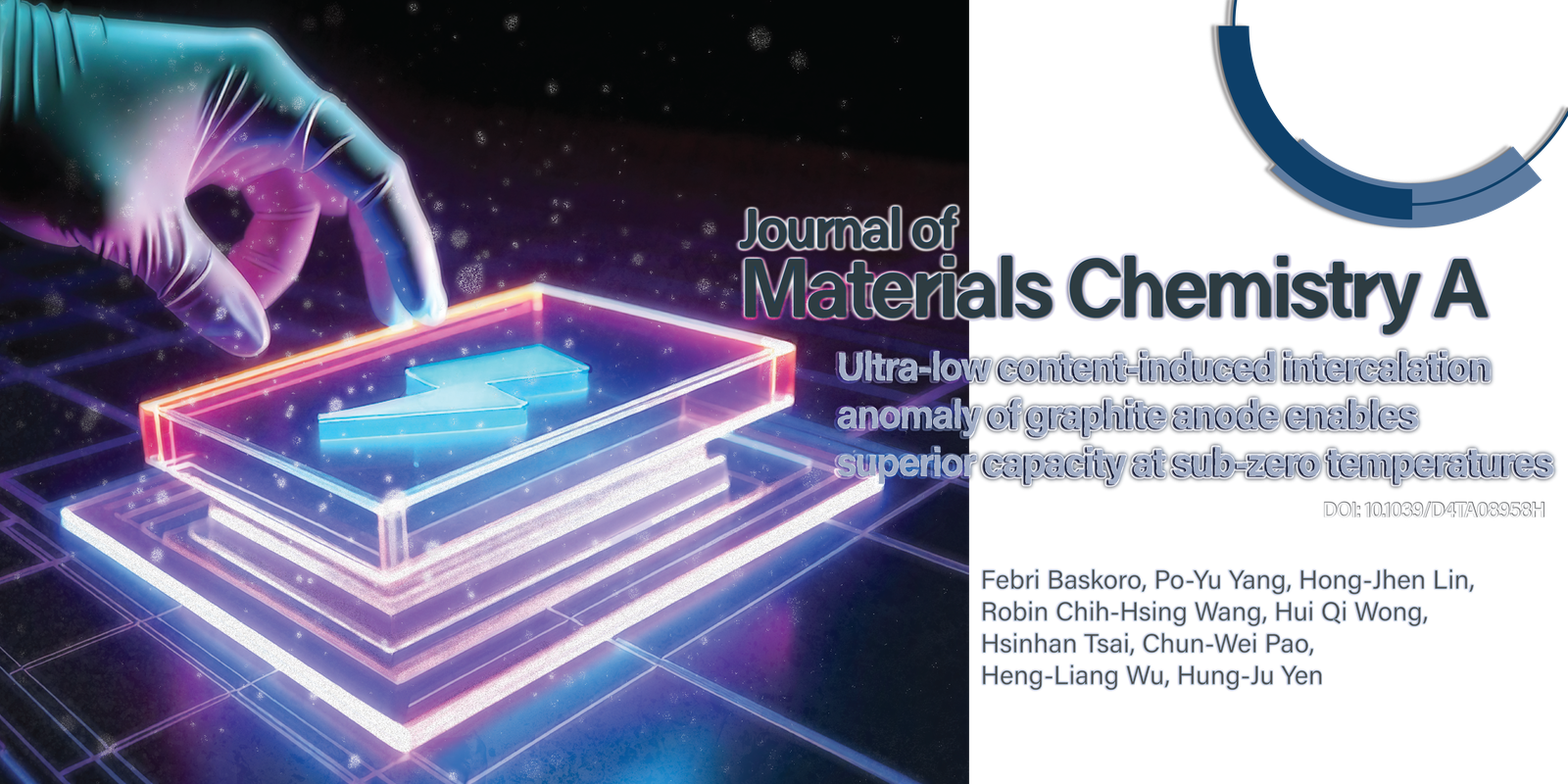Institute of Chemistry, Academia Sinica – Research
超低含量的石墨負極材料誘發特殊鋰離子嵌入現象以及低溫環境下卓越的電池效能
Ultra-low Content Induced Intercalation Anomaly of Graphite Anode Enables Superior Capacity at Sub-zero TemperaturesJ. Mater. Chem. A 2025, DOI: 10.1039/D4TA08958H
Febri Baskoro, Po-Yu Yang, Hong-Jhen Lin, Robin Chih-Hsing Wang, Hui Qi Wong, Hsinhan Tsai, Chun-Wei Pao*, Heng-Liang Wu*,Hung-Ju Yen*

The rapid advancement of energy storage has pushed Li-ion batteries (LIBs) toward higher performance, better safety, lower cost, and wider temperature adaptability. However, conventional LIBs typically underperform in extreme environments—such as ocean exploration, tropical regions, high-altitude drones, and polar expeditions—due to hindered ion conductivity, interfacial instability, and sluggish Li⁺ desolvation. While graphite is widely used as a negative electrode for its mechanical stability, conductivity, affordability, and abundance, its limited Li⁺ storage capacity (372 mA h g-1 via LiC₆ formation) restricts further development.
In this study, we introduce an intercalation anomaly enabled by ultra-low graphite content in the electrode, achieving a super-lithiation stage. By reducing graphite and increasing conductive filler, we created a highly conductive electrode capable of ultrahigh rate performance—2200 mA h g⁻¹ at 1C and 1100 mA h g⁻¹ at 30C. Remarkably, even at −20 °C, the anode retained 50% of its room temperature capacity, outperforming any other LIB anodes.
Spectroscopic analysis revealed a capacitive behavior and structural evolution leading to an intercalation limit beyond LiC₆, up to LiC₂. This structural anomaly significantly boosts capacity and enhances low-temperature performance by mitigating desolvation and diffusion limitations. These findings offer a novel perspective on graphite chemistry and open new possibilities for high-performance, anode-less LIBs in harsh environments.
隨著能源儲存技術的迅速發展,鋰離子電池正朝向更高的性能、更佳的安全性、更低的成本,以及更廣泛的操作溫度範圍邁進。然而,傳統鋰離子電池在極端環境下(如海洋探勘、熱帶地區、高空無人機與極地探險)之應用仍面臨重大挑戰,主要歸因於離子導電性受阻、界面不穩定性,以及鋰離子去溶劑化過程遲滯等問題。
石墨因具備優異的機械穩定性、導電性、成本效益與資源豐富等優勢,長期被視為鋰離子電池負極之標準材料。然而,其透過 LiC₆ 結構所達之理論鋰離子儲存容量(372 mA h g⁻¹)已成為限制其進一步應用之瓶頸。
本研究提出一種因極低石墨含量而誘發之異常插層現象,使石墨電極得以達到超鋰化階段。透過降低石墨含量並增加導電材料,成功構建出一種高導電性之電極系統,展現出卓越的高倍率性能——於1C倍率下達 2,200 mA h g⁻¹,於 30C 倍率下仍可達 1,100 mA h g⁻¹。值得一提的是,在零下負 20 °C 低溫操作下,該負極仍可維持其於室溫電容量之 50%,此表現明顯優於現今所有鋰電池負極材料。
在電池效能之外,光譜分析顯示此電極系統具有額外之電容行為與明顯之結構進化,致使鋰離子之插層能力突破傳統 LiC₆ 限制,並提升至 LiC₂。此一系統顯著地提升了電池效能,並有效改善低溫下的去溶劑化與擴散限制。此研究為碳材料之電化學機制提供了全新觀點,並為未來發展高性能、無負極鋰離子電池於極端環境中之應用奠定重要基礎。
